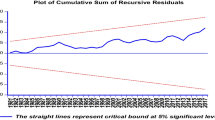Abstract
This paper re-examines the relationship between fiscal imbalances and net foreign borrowing. A general analytical approach is first developed which suggests that, other things equal, a rise (fall) in any advanced economy’s fiscal deficit should be fully matched by a rise (fall) in its net foreign borrowing, in accordance with the so-called twin deficits hypothesis. In the case of Australia, one of the world’s largest foreign borrower economies for its size, empirical estimation yields the novel result that Australia’s consolidated budget imbalance and its foreign borrowing were approximately twinned on the basis of quarterly data for 1983–2009, when Australia’s exchange rate floated and international capital mobility was high. This result is consistent with the conceptual framework and suggests that fiscal policy is likely to be ineffective as an instrument for influencing the real economy.
Similar content being viewed by others
References
Andrews D (1993) Tests for parameter instability and structural change with unknown change point. Econometrica 61: 821–856
Andrews D, Ploberger W (1994) Optimal tests when a nuisance parameter is present only under the alternative. Econometrica 62: 1383–1414
Auerbach A, Gale W, Harris B (2010) Activist fiscal policy. J Econ Perspect 24(4): 141–164
Australian Bureau of Statistics, Australian National Accounts, Catalogue No. 5206. Australian Government Printing Service, Canberra
Australian Bureau of Statistics, Balance of Payments and International Investment Position, Australia, Catalogue No. 5302. Australian Government Printing Service, Canberra
Australian Treasury (2011) Commonwealth Budget 2011–2012, Australian Government Printing Service, Canberra
Barro R (1974) Are government bonds net wealth?. J Political Econ 81: 1095–1117
Chinn M, Prasad E (2003) Medium term determinants of current accounts in industrial and developing countries: an empirical exploration. J Int Econ 59: 47–76
Corsetti G, Muller G (2006) Twin deficits: squaring theory, evidence and common sense”. Econ Policy 48: 597–638
Dibooglu S (1997) Accounting for US current account deficits: an empirical investigation. Appl Econ 29(6): 787–793
Engle RF, Granger CWJ (1987) Co-integration and error correction: representation, estimation and testing. Econometrica 55: 251–276
Fleming J (1962) Domestic financial policy under fixed and floating exchange rates. IMF Staff Papers 9(3): 79–369
Gregory A, Hansen B (1996) Residual based tests for cointegration in models with regime shifts. J Econ 70: 99–126
Hansen B (1997) Approximate asymptotic p-values for structural-change tests. J Bus Econ Stat 15: 60–67
Hatemi JA (2008) Tests for cointegration with two unknown regime shifts with an application to the financial market integration. Empir Econ 35: 497–505
Kim S, Roubini N (2008) Twin deficits or twin divergence? Fiscal policy, current account, and real exchange rate in the US. J Int Econ 74: 362–383
Kraay A, Ventura J (2000) Current accounts in debtor and creditor countries. Q J Econ 115: 1137–1166
Makin A (2003) Global finance and the macroeconomy. Palgrave Macmillan, Basingstoke
Makin A (2004) The current account, fiscal policy and medium run income determination. Contemp Econ Policy (22):309–317
Makin A (2009) Global imbalances, exchange rates, and stabilization policy. Palgrave Macmillan, Basingstoke
Mankiw G (2012) Macroeconomics, 8th edn. Worth, New York
Masson P, Bayoumi T, Samiei H (1998) International evidence on the determinants of private saving. World Bank Econ Rev 12: 483–501
Mundell R (1963) Capital mobility and stabilization policy under fixed and flexible exchange rates. Can J Econ Political Sci 29(4): 475–485
Narayan P, Popp S (2009) A new unit root test with two structural breaks in level and slope at unknown time. J Appl Stat 37(9): 1425–1438
Narayan P, Smyth R (2005) Structural breaks and unit roots in Australian macroeconomic time series. Pac Econ Rev 10: 421–437
Nason J, Rogers J (2002) Investment and the current account in the short run and the long run. J Money, Credit Bank 34:967–986
Normandin M (1999) Budget deficit persistence and the twin deficits hypothesis. J Int Econ 49: 171–193
Phillips P (1987) Times series regression with a unit root. Econometrica 55(2):277–301
Ricciutti R (2003) Assessing Ricardian equivalence. J Econ Surv 17(1): 55–78
Seater J (1993) Ricardian equivalence. J Econ Lit 31(1): 142–190
United Nations (2009) System of National Accounts, 2008. United Nations, New York
Author information
Authors and Affiliations
Corresponding author
Rights and permissions
About this article
Cite this article
Makin, A.J., Narayan, P.K. Re-examining the “twin deficits” hypothesis: evidence from Australia. Empir Econ 45, 817–829 (2013). https://doi.org/10.1007/s00181-012-0628-7
Received:
Accepted:
Published:
Issue Date:
DOI: https://doi.org/10.1007/s00181-012-0628-7



